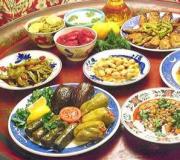Polenov Vasily golden autumn year. Educational essay based on V.D. Polenov’s painting “Golden Autumn”
In the painting by artist V.D. Polenov’s “Golden Autumn” depicts a piece of the world where the artist lived and worked: the Oka River with its banks in the very middle of autumn, a bird’s-eye view. Such picturesque places have always touched the heart of a Russian person - the vastness, free air and beauty of the native land, which always lives in the heart, no matter where you go. It’s easy to imagine how a person who accidentally saw and realized this beauty takes a deep breath and sings.
A beautiful powerful voice flows over the river, the echo carries it far, far away, and the Russian song flying over the water takes on a life of its own. I want to sing loudly, hearing the splash of my native Oka, seeing the vastness of its open spaces, warmed by the last rays of the sun. Soon this beauty will disappear: a cold wind will blow and the leaves will fly away, the landscape will be depressing with bare tree branches, this secluded little world will no longer exist.
The eye will look lonely through the exposed gaps. But for now she is not visible through this lush foliage. Perhaps the artist is observing this picture from a hill, imagining himself as a bird flying over his native expanses. He sees a road illuminated by the sun, on which bushes that have not yet turned yellow are visible, the grass around it is green almost everywhere. But autumn is already coming into its own, adding a yellow-crimson tint, and the riotous colors seem to hint at their fragility and imminent disappearance.
The road leads through the forest to a hill where a lonely church stands white. One can imagine how the artist walked to the place from where he observes all this beauty: from the side of the church, through the open woods - somewhere there, behind the hill, probably small wooden houses, livestock, palisades, ordinary peasant life...
On the opposite bank of the river you can still see a green plain, which is probably flooded with meltwater in the spring - this can be understood by the sandbank. There are almost no bushes on this bank, a ravine is visible - the river is gaining more space, wanting to expand its channel, and is tirelessly eroding the bank.
The river itself is, as it were, the center of the picture, the banks are its colorful frame. Curved in the shape of a sickle, it does not look lonely yet; it reflects autumn in all its colors. The river carries its calm waters somewhere far away, to distant hills, meandering straight to the horizon.
The artist sighs, daydreaming, and shakes off the numbness that has taken possession of him... His gaze again returns to the high bank of the river overgrown with forest, which is located right in front of him. Living colors - golden, green, crimson-brown - again return him from the land of dreams to the present.
The artist stands for a minute, raising his head and watching the sky full of clouds. He enjoys the fragility of the moment. Maybe tomorrow this beauty will be disturbed by wind or rain. But for now – the last moments of warm autumn, and we need to capture them – in memory and on canvas. Yes, exactly this piece of our native, vast Russia. And the artist sits down and begins to create...
I look at this picture and try to understand what the great Polenov felt when he painted it. Probably admiration. The painting speaks of the tranquility of nature and the beauty of the moment the artist saw. But one thing is clear: Polenov loved his homeland. Its vast expanses, the splendor of nature, and he understood the value of the moment. Together with him I admire and deeply breathe in the air of the vastness of my native land. Yes! It is impossible not to love Russia.
One can only feel its greatness, be proud and believe in the future, looking into the foggy distances. Of course I liked this picture. Remembering her in the bustle of the big city, you will sigh furtively and want to go where beauty is poured out in everything - to nature... And now I’m going out of town. Not Polenov’s painting, of course... but still... this is Russia.
The wonderful time of golden autumn has come. V.D. Polenov very accurately depicted this time of year “Forests dressed in scarlet and gold” - as if looking at this picture, writes A.S. Pushkin.
In the foreground of the picture you can still see green grass. The dark spots are small fir trees.
In the middle ground of the picture, all the beauty of autumn Russian nature is revealed. When you look at these trees, your soul is filled with delight and joy. Such mighty pines and spruces stand green on the left side of the picture, but against their background the multi-colored trees have become even more expressive.
In the background of the picture there is not a large village, but a church next to it. Behind the fence of golden trees there is still a rather green and mighty oak tree.
And what a sky! The words of Alexander Pushkin just burst from the soul: “And the heavens are covered with a wavy haze...”. The sky is still bright, but the winter darkness is already somewhere close. Vasily Dmitrievich Polenov is a famous Russian painter. I saw his paintings in the Tretyakov Gallery and was very admired.
Vasily Dmitrievich Polenov is a famous artist. He can be called a painter of nature. He created many landscapes that you still want to admire to this day. One of the artist’s most dedicated paintings is “Golden Autumn” by Polenov. You can start with a short story about himself to understand why he loved nature so much.
Biography of the painter and his love for nature
Vasily Dmitrievich was born on May 20, 1844 into an enlightened large noble family in the Borog estate near Tula. The child had access to the beauty of the surrounding nature from an early age, which, of course, influenced his artistic taste. Mom also drew him well, although she was a writer. My father was an archaeologist. His grandmother Vera Nikolaevna Voyenkova played a major role in shaping the boy’s artistic taste. She came up with interesting competitions for her grandchildren. Grandma gave medals to the children for the best painting. All his life Polenov remembered his vivid impressions of the pristine nature of the Olenets region, where he traveled with his grandmother. All this and talent helped form such a great artist.

Description of the painting “Golden Autumn” by Polenov
The artist created this work in 1893. The picture attracts the eye from the very first seconds of contemplation. It is evident with what love the artist depicted his native nature at the very beginning of autumn. Many artists loved this time and dedicated their masterpieces to it. For example, Alexander Sergeevich Pushkin. Golden autumn was his favorite time. He praised her in his poetic works. And Vasily Dmitrievich Polenov could not help but capture the natural charm.
The description of the painting “Golden Autumn” by Polenov was made by experts in his painting. They note that the artist created the picture in his own style. He organized space on the canvas using a technique such as an arc. Its role here is played by grass and trees growing along its riverbed. On the left bank there are endless fields, on the right bank trees have found shelter. These are mainly birch trees. The yellowness of their foliage is set off by the majestic ones, which are also green in color. Against the background of this proud giant, who has spread his branches widely, the white-trunked birches look even more graceful and slender.
What do you dream about when looking at a masterpiece?

The description of the painting “Golden Autumn” by Polenov can be continued with a story about the blue sky. It is in great harmony with Oka. The same soft blue. The clouds are slightly yellowish and the duckweed on the water has the same shade. The picture seems to be saturated with sunlight. He is everywhere. The sun gilded the crowns of trees, grass and even clouds. This is such magnificence that Polenov created. “Golden Autumn” is a picture that awakens dreams. Looking at it, you want to be in this region, to walk along the path that stretches along the birches. I want to go down to the river, look at its waters and breathe fresh air. When you look at the hills, which are outlined by soft lines, a desire awakens to lie down on their silken grass, inhale its aroma and expose your face to the rays of the still bright sun.
These are the dreams and desires that the painting “Golden Autumn” awakens. At the time of painting, Polenov had lived in these parts for 22 years; he had the good fortune to admire such beauties and leave them for posterity, capturing them on canvas.
"Gold autumn".Tasks of the teacher: create conditions for compiling and recording a text based on the reproduction of V. D. Polenov’s painting “Golden Autumn”.
Lesson type: solving particular problems.
Planned learning outcomes:
Subject: will learn compose a text on a reproduction of a painting (consider and describe the content of a reproduction of a painting, discuss the content of an upcoming story based on a reproduction of a painting, highlight parts of the content of a story), write down the compiled text.
Meta-subject (criteria for the formation/assessment of components of universal learning activities - UUD):
Cognitive: navigate the textbook, answer the teacher’s questions, find the necessary information intextbook.
Regulatory: organize your workplace, determine the goal and draw up a plan for completing tasks in the lesson under the guidance of the teacher.
Communicative: listen and engage in dialogue, participate in collective discussion.
Personal: have the skills of constructive cooperation with adults and peers, and demonstrate aesthetic feelings.
Educational Resources:
1. Textbook, workbook.
2. Explanatory dictionary.
3. Internet resources:
Visual demonstration material: words for spelling training written on the board.
Lesson script
I. Report the topic of the lesson.
– Today is a lesson on speech development.
– During the lesson we will compose a text on the reproduction of Vasily Dmitrievich Polenov’s painting “Golden Autumn”: consider and describe the content of the reproduction of the painting, discuss the content of the upcoming story based on the reproduction of the painting, highlight parts in the content of the story, write down the compiled text.
II. Getting to know the artist's work.
– Polenov Vasily Dmitrievich - an outstanding Russian artist, master of historical, landscape and genre painting(the teacher demonstrates reproductions of paintings: “Grandma’s Garden” (1878), “Moscow Courtyard” (1878), “First Snow” (1891), “Overgrown Pond” (1879), “Russian Village” (1889), “Birch Alley in Abramtseve" (1880)) , teacher. Born on May 20, 1844 in St. Petersburg, into an old noble family. Polenov's father, Dmitry Vasilyevich, was a famous historian, archaeologist and bibliographer. The artist's mother, Maria Alekseevna, was a children's writer and amateur artist.
III. Mastering new content and its application: work according to the textbook (p. 37).
1. Consideration and description of the content of the reproduction of the painting.
– Look at the reproduction of the painting(the teacher demonstrates a reproduction of the painting using an interactive whiteboard) .
– What did the artist depict in the picture?(The artist depicted early autumn.)
– Why do you think so?(The artist used soft yellow, blue and green tones when painting the picture.)
– Autumn is the artist’s favorite time of year.
– Did you get the impression that you were seeing the autumn landscape as if from above?(Yes. The artist probably climbed onto a hill and spent a long time choosing the place from which he would paint.)
– What do you see in the center of the picture?(River.)
– It should be noted that Polenov used in the painting a technique characteristic of his style: organizing space using an arc. On the canvas, the role of this arc is the image of the Oka River, which balances and completes the picture as a whole. The river stretches, dividing the picture
into two parts. Oka is Polenov’s favorite place. “How I would like to show you our Oka. After all, you and I were the first to discover its beauty. Then for some reason it seemed to you that in this beauty and harmony, no, no, and even a harmonic would slip through. I’ve been living here now for twenty-two years and have never heard it, but the beauty and harmony are still the same.”(From the artist’s letter to K. Korovin.)
– How did you see the river and its banks?(It is a mirror of the entire landscape. It reflects the trees that grow along the river and the blue sky. The shore is strewn with clean, as if sifted, sand. In the summer, village children play and swim there.)
– How did you see the water meadows stretching towards the horizon?(Green islands are visible on the ocher-yellow grass.)
– How did you see the trees and their autumn attire, the earth?(In the midst of golden trees, young green pines shine through, and three old pines growing nearby rise above them. A path trampled by local residents leads into a dense forest. There they collect mushrooms and wild berries. In the lower right corner of the picture you can see the shadow of a large tree. )
– How did you see the sky?(In the blue sky, through which air clouds float, clouds, grayness and other signs of bad weather are not visible.)
– What do you remember about the film?(The painting exudes coolness and silence. I want to dissolve in the gentle beauty and harmony, think about the smooth and leisurely flow of life. It is clear that part of the author’s soul has forever frozen in the work, filling it with warmth and soft inner light.)
2. Writing a story.
– How many parts will there be in the story?(Three parts: introductory, main, final.)
– What will you write about in the first part?(About the artist, his painting.)
– What will you write about in the main part?(We will give a description of the nature depicted in the picture.)
– How will you end your story? What words will you use to start sentences in which you express your opinion, your impressions of the picture?(Students' statements.)
3. Retelling the compiled story.
– What will you tell us in the introductory part?(About the artist, his painting.)
– (Two or three sentences.)
– Now think about what you will talk about in the main part?(About the content of the picture.)
– How many proposals will this require?(At least five sentences.)
– What will you talk about in conclusion?(About why you like the picture.)
– How many proposals will this require?(One or two sentences.)
– Retell the text.(1–2 students retell the compiled text.)
– Does the content of the story fit the theme?
– How many parts are there in the story?(3.)
Physical education minute
4. Lexico-spelling preparation.
Words for spelling trainingon the board: painting, early autumn, autumn landscape, we see, calm, blue, river, yellow, copses, golden, birch trees, as if dancing, light, round dance, towering, greenery, giant trees, earth, yellowed, grass, path , swiftly, running, calling, horizon, aspic, blowing, coolness, silence.
– Read the first word spellingly.(Painting.)
– What do you need to know to spell this word correctly?(This is a dictionary word. You need to remember its spelling, namely: the unstressed vowel at the root of the word - the letter “a”.)
Work with other words in the same way.
5. Writing sentences in a notebook.
–Write down suggestions for reproducing the painting.
Option 1
The picture shows early autumn. We see the autumn landscape as if from above. The river calmly rolls its blue waters. There are yellow copses everywhere. Golden birches seem to be dancing in a light round dance. The dense greenery of giant trees rises above them. There is yellowed grass on the ground. The path runs quickly and calls us into the distance. Water meadows stretch towards the horizon.
The painting exudes coolness and silence.
Option 2
During the Russian language lesson, the teacher presented paintings by the artist Vasily Dmitrievich Polenov. What struck me most was his painting “Golden Autumn”.
The picture shows early autumn. We see the autumn landscape as if from above. The painting is made in soft yellow, blue and green tones. In the midst of golden trees, young green pines shine through, and three old pines growing nearby rise above them. Green islands are visible on the ocher-yellow grass. In the blue sky, across which air clouds float, no clouds are visible. The river is a mirror of the entire landscape. The river surface reflects the trees that grow along the banks and the blue sky. The river stretches, dividing the picture into two parts. The shore is strewn with clean, as if sifted, sand. In summer, village children play and swim there. A trampled path leads into a dense forest. There, local residents collect mushrooms and wild berries. In the lower right corner of the picture you can see the shadow of a large tree.
It is clear that part of the artist’s soul has frozen forever in the work, filling it with warmth and soft inner light.
6. Mutual verification.
7. Reading written sentences.
IV. Lesson summary. Reflection of activity.
– What lesson did you teach today?(Lesson on speech development.)
– What did you compile and write down?(Text based on the reproduction of the painting.)
–How did you cope with the work? What caused the difficulties? How do you evaluate your activities in class?




